For many years South Koreans have sought an escape from the victimization of the Korean War, and the whirl of economic development that is sweeping the country. Desiring to find a place to step back from it all, many have turned to Cheju Island, the southern-most province of South Korea. This volcanic island, closely resembling Hawaii in both its scenery and its relaxing outlook, has traditionally been seen as the isle of vacation, relaxation and a prime location for that singular event in our lives which epitomizes emotional fulfillment: honeymoons.
Immediately upon arriving in the airport, newlyweds, still in their wedding clothes, can be seen passing through the main entrance, where they stop to touch one of the many "stone grandfather" statues throughout the island. The belief is that by touching the grandfather's nose, your first child would be a boy, touching the ears would bring a girl.
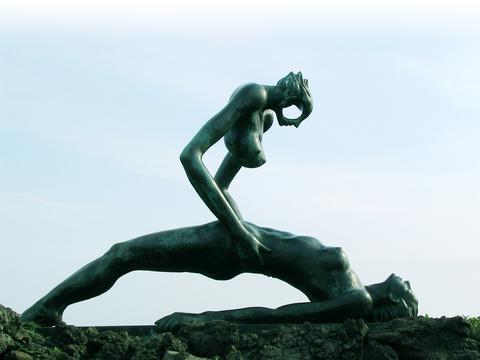
PHOTOS: RICHARD KAGAN, TAIPEI TIMES
Haven or heaven?
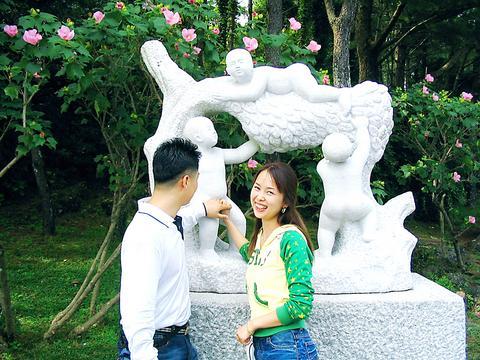
PHOTOS: RICHARD KAGAN, TAIPEI TIMES
Traveling around the island, we found that it lives up to its reputation as a haven of relaxation and enjoyment. However, the one place that stood out as the hallmark of the richness of the human spirit was the Cheju Art Park. Throughout this sculpture garden, newlyweds, as numerous as the statues in the park, stroll along the forested paths and beside the softly rushing streams. During our afternoon trip there in September, we had the opportunity to meet several of these new couples and discuss how these sculptures relate to their new life.
Cheju Island lies within a two-hour flight from every airport in northeast Asia (South Korea, Japan, Taiwan and Eastern China), and forms the point from which every major region in East Asia radiates. North and South Korea are north of the island, Japan to the west, China to the east and Taiwan to the south. Mount Halla, the central volcano on this island of fire rises up from the center of Cheju forming the central hub of all East Asia. Despite its turbulent history during World War II as a base from which Kamikaze pilots would begin their final journey, Cheju turned toward a heartfelt promotion of peace and the development and expression of human beauty and emotion after the lifting of martial law in the 1980s. This blossoming was what earned Cheju the reputation as a location for natural beauty, relaxation and vacations. Thousands of newlyweds flock to Cheju each year to celebrate the beginning of their new lives together.
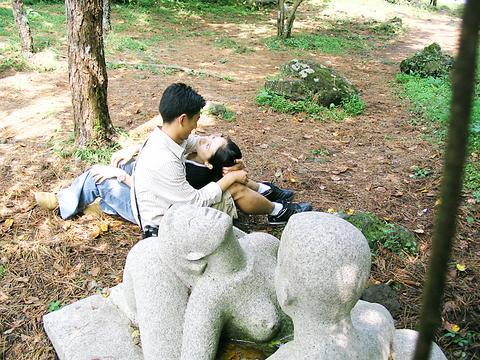
Sorrows of war
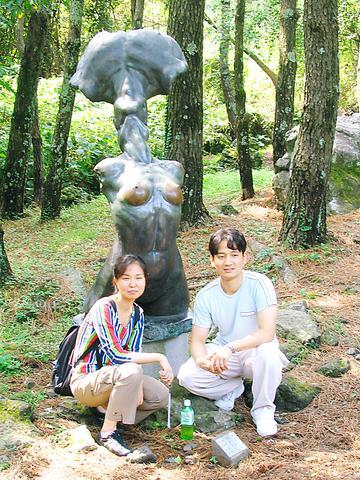
"Despite the sorrows of the war, the people here are still optimistic," said Ahn Byung-duk, the founder of the Cheju Art Park. With this philosophy in mind, he set out to create a sculpture park which through flowing lines and the sensual curves of the statues, would serve as a perfect destination for newlyweds or anyone desiring to experience a union of nature, beauty and the human spirit. From the beginning the park received some 240,000 visitors a year, many of them newlyweds.
Located in the midst of persimmon orchards and tea plantations in the southwest portion of the island overlooked by Mount Sanbang, Cheju's second largest volcano, this park is a one hour car ride from Cheju City and only 20 minutes from Seogwipo City. Several car rental outlets are available in the major cities, charging about 80,000 won (US$70) a day.
"Upon entering the park, I immediately felt that this was a haven for newlyweds," said Mrs. Kim, one of the visiting honeymooners. Wearing matching golden necklaces, bracelets, and rings, she and her husband had been married only one day before. We encountered Mr. and Mrs. Kim while walking through one of the many secluded forest paths that wind through the park.
We followed them back to the main courtyard at the park's entrance. The park is entered through an open-air corridor flanked by high stone walls and overshadowed by hanging branches. This dark corridor bursts open into a wide courtyard as visitors are metaphorically born into a world emphasizing the union of the beauty of nature and of the human spirit.
Mr. and Mrs. Kim lead us to a marble statue called the Mind of the Children. We later discovered from Ahn, the founder of the park, that this is the most popular statue on the premises. The statue by Shin Suk-pil features three naked baby boys frolicking around a growth of grape vines in the carefree abandonment of Dionysian pleasure. When looking at the statue for the second time that day, Mr. and Mrs. Kim could not resist posing once again in front of the statue for us. Like the stone grandfather at the airport, the popularity of this statue is attributed to the strong patrilineal nature of Korean culture. The presence of the three male children creates the belief that by touching the statue it will ensure the first child is male.
Entering deeper into the park we encountered Mrs. Chong, a sales worker at a mobile phone company in Seoul who married her co-worker one day before, standing in front of a small garden called the Forest of Love. Mrs. Chong translated the name as the "Forest of Oohs," softly imitating the cooing of two honeymooners. This garden was particularly inspiring to newlyweds. Mrs. Chong was captivated by the Sound of Thunder, in which the power of a kiss strikes down through a woman's arched body. The man, flying from the heavens meets the woman
Flash of lightning
After our discussion with Mr. and Mrs. Chong, we lingered in the Forest of Love, enjoying the tranquility of the afternoon. Turning out onto the main path, we encountered Mr. and Mrs. Lee Yuk. A casual "good afternoon" led to a discussion of the statues. Mrs. Lee grabbed her husband's hand, and led us to a statue called The Mountain. This statue, by O Sang-ouk, depicts two lovers reclining in each other's arms. The curve of their legs, the angle of their heads, and the expression of their faces all serve to draw the viewer upward toward the sky, in the same way that mountain peaks draw the human spirit toward heaven. "Seeing this statue makes me want to settle down and start a family, I want to start nesting." Mrs. Lee told us.
The lightness of being
The statues throughout the park have a persistent theme of weightlessness, an urgent movement toward the rising sun. They draw the viewer out of the mundane world and up toward the sky, connecting both heaven and earth. They raise us into the natural world, as well as connecting us with each other through emotions which are consistent regardless of culture. Nowhere was this uplifting feeling exemplified more than Lee Il-ho's statue Morning.
This statue rises from the top of the tallest hill in the park in the form of a woman in the rapture of the sunrise. The sun is represented by a second woman shown only from the waist up. This woman hovers above the first, reaching down with long arms to lift up the other. The expression on the sun's face represents the compassion of light and heat coming to comfort a cold land. This combines with the ecstasy on the face of the second woman as the sun's light reaches her and life springs again into her body.
Located within two hours of Taiwan, Cheju is a compact island which needs only one day off from your journey to explore. People seeking a respite from the turmoil of daily life will find peace. Couples can enjoy a park which creates an aesthetic complement to their emotions. The Cheju Art Park creates a sense of connection within the family, of nurture and care, a connection between the human spirit and the natural world. You will leave the island with a new appreciation of the world and the people around you.

From the last quarter of 2001, research shows that real housing prices nearly tripled (before a 2012 law to enforce housing price registration, researchers tracked a few large real estate firms to estimate housing price behavior). Incomes have not kept pace, though this has not yet led to defaults. Instead, an increasing chunk of household income goes to mortgage payments. This suggests that even if incomes grow, the mortgage squeeze will still make voters feel like their paychecks won’t stretch to cover expenses. The housing price rises in the last two decades are now driving higher rents. The rental market
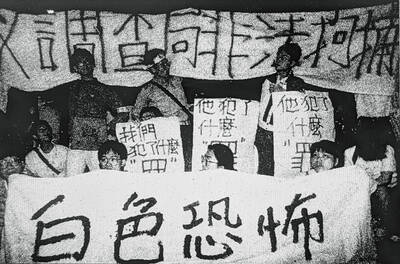
July 21 to July 27 If the “Taiwan Independence Association” (TIA) incident had happened four years earlier, it probably wouldn’t have caused much of an uproar. But the arrest of four young suspected independence activists in the early hours of May 9, 1991, sparked outrage, with many denouncing it as a return to the White Terror — a time when anyone could be detained for suspected seditious activity. Not only had martial law been lifted in 1987, just days earlier on May 1, the government had abolished the Temporary Provisions Effective During the Period of National Mobilization for Suppression of the Communist
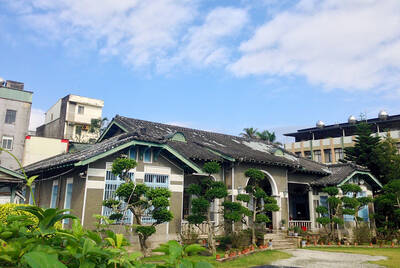
When life gives you trees, make paper. That was one of the first thoughts to cross my mind as I explored what’s now called Chung Hsing Cultural and Creative Park (中興文化創意園區, CHCCP) in Yilan County’s Wujie Township (五結). Northeast Taiwan boasts an abundance of forest resources. Yilan County is home to both Taipingshan National Forest Recreation Area (太平山國家森林遊樂區) — by far the largest reserve of its kind in the country — and Makauy Ecological Park (馬告生態園區, see “Towering trees and a tranquil lake” in the May 13, 2022 edition of this newspaper). So it was inevitable that industrial-scale paper making would

Hualien lawmaker Fu Kun-chi (傅?萁) is the prime target of the recall campaigns. They want to bring him and everything he represents crashing down. This is an existential test for Fu and a critical symbolic test for the campaigners. It is also a crucial test for both the Chinese Nationalist Party (KMT) and a personal one for party Chairman Eric Chu (朱立倫). Why is Fu such a lightning rod? LOCAL LORD At the dawn of the 2020s, Fu, running as an independent candidate, beat incumbent Democratic Progressive Party (DPP) lawmaker Hsiao Bi-khim (蕭美琴) and a KMT candidate to return to the legislature representing